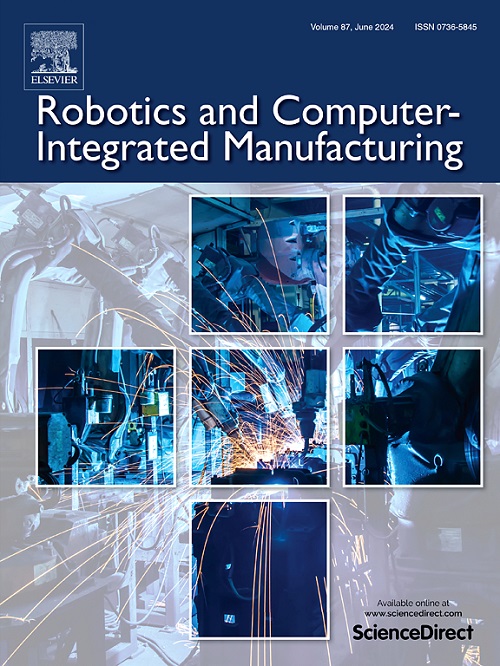Safety-efficiency integrated assembly: The next-stage adaptive task allocation and planning framework for human–robot collaboration
IF 9.1
1区 计算机科学
Q1 COMPUTER SCIENCE, INTERDISCIPLINARY APPLICATIONS
引用次数: 0
Abstract
Human–robot collaboration (HRC) has sparked a new wave of the resilient, sustainable, and human-centric industrial revolution. In HRC-enabled manufacturing, safety is a constant focus since the traditional physical barriers between robots and humans are removed. Meanwhile, ensuring efficiency has also gained considerable attention with the rise in production demands and market competition. However, the integration and balance between these two critical prerequisites are overlooked in the task allocation and planning phase of the HRC assembly. In this paper, an adaptive task allocation and planning framework is proposed by simultaneously considering the safety and efficiency of HRC assembly. First, an execution time optimization strategy (ETO) is presented. This strategy adaptively adjusts safety paradigms in the spatio-temporal shared workspace. Thereby, the execution time of assembly tasks is well optimized while ensuring human–robot safety. Second, based on ETO and collaborative assembly task requirements, the safety-efficiency integrated assembly planning problem (SEAPP) is proposed and modeled. Third, compared to conventional single-objective HRC assembly planning problems, the solution space of SEAPP is significantly expanded, leading to a substantial increase in optimization complexity. Thus, a novel constrained multi-objective co-evolutionary algorithm, called GDCA, is proposed. By combining the complementary advantages of different evolutionary operators, GDCA enhances the diversity of solutions while ensuring convergence of optimization process. In comparison with variants that rely solely on a single evolutionary strategy, GDCA maintains better and more stable performance, validating the effectiveness of the co-evolutionary process. GDCA is also compared with four state-of-the-art constrained multi-objective optimization algorithms across a variety of SEAPP instances, widely spanning different task scales and durations. Across 20 assembly instances, GDCA shows superior over NSGA-II, PPS, BiCo, and MCCMO in 17, 19, 18, and 17 instances, and better in 17, 19, 17, and 17 instances, respectively. Furthermore, the feasibility and effectiveness of the proposed SEAPF are validated by an industrial challenge in the HRC computer assembly. While ensuring safety, it significantly reduces the total assembly completion time, achieving a 6.2% time reduction over the SSM paradigm and 47.8% over the PFL paradigm, respectively.
安全高效集成装配:人机协作的下一阶段自适应任务分配和规划框架
人机协作(Human-robot collaboration, HRC)引发了一场有弹性的、可持续的、以人为中心的新浪潮。在支持hrc的制造业中,由于机器人和人类之间的传统物理障碍被消除,安全一直是一个焦点。与此同时,随着生产需求的增加和市场竞争的加剧,确保效率也受到了相当大的关注。然而,在人权理事会大会的任务分配和规划阶段,忽视了这两个关键先决条件之间的整合和平衡。本文提出了一种同时考虑HRC装配安全性和效率的自适应任务分配和规划框架。首先,提出了一种执行时间优化策略。该策略自适应地调整了时空共享工作空间中的安全范式。从而在保证人机安全的同时,很好地优化了装配任务的执行时间。其次,基于ETO和协同装配任务需求,提出了安全-效率集成装配规划问题(SEAPP)并建立了模型。第三,与传统的单目标HRC装配规划问题相比,SEAPP的求解空间得到了显著扩展,优化复杂度大幅提高。为此,提出了一种约束多目标协同进化算法GDCA。GDCA通过结合不同演化算子的互补优势,在保证优化过程收敛的同时增强了解的多样性。与仅依赖单一进化策略的变体相比,GDCA保持了更好、更稳定的性能,验证了共同进化过程的有效性。GDCA还在各种SEAPP实例中与四种最先进的约束多目标优化算法进行了比较,广泛跨越不同的任务规模和持续时间。在20个装配实例中,GDCA在17、19、18和17个装配实例中表现出优于NSGA-II、PPS、BiCo和MCCMO的IGD,在17、19、17和17个装配实例中表现出更好的HV。此外,通过HRC计算机组件的工业挑战验证了所提出的SEAPF的可行性和有效性。在确保安全性的同时,它显著缩短了总组装完井时间,比SSM模式减少了6.2%,比PFL模式减少了47.8%。
本文章由计算机程序翻译,如有差异,请以英文原文为准。
求助全文
约1分钟内获得全文
求助全文
来源期刊
CiteScore
24.10
自引率
13.50%
发文量
160
审稿时长
50 days
期刊介绍:
The journal, Robotics and Computer-Integrated Manufacturing, focuses on sharing research applications that contribute to the development of new or enhanced robotics, manufacturing technologies, and innovative manufacturing strategies that are relevant to industry. Papers that combine theory and experimental validation are preferred, while review papers on current robotics and manufacturing issues are also considered. However, papers on traditional machining processes, modeling and simulation, supply chain management, and resource optimization are generally not within the scope of the journal, as there are more appropriate journals for these topics. Similarly, papers that are overly theoretical or mathematical will be directed to other suitable journals. The journal welcomes original papers in areas such as industrial robotics, human-robot collaboration in manufacturing, cloud-based manufacturing, cyber-physical production systems, big data analytics in manufacturing, smart mechatronics, machine learning, adaptive and sustainable manufacturing, and other fields involving unique manufacturing technologies.

 求助内容:
求助内容: 应助结果提醒方式:
应助结果提醒方式:


